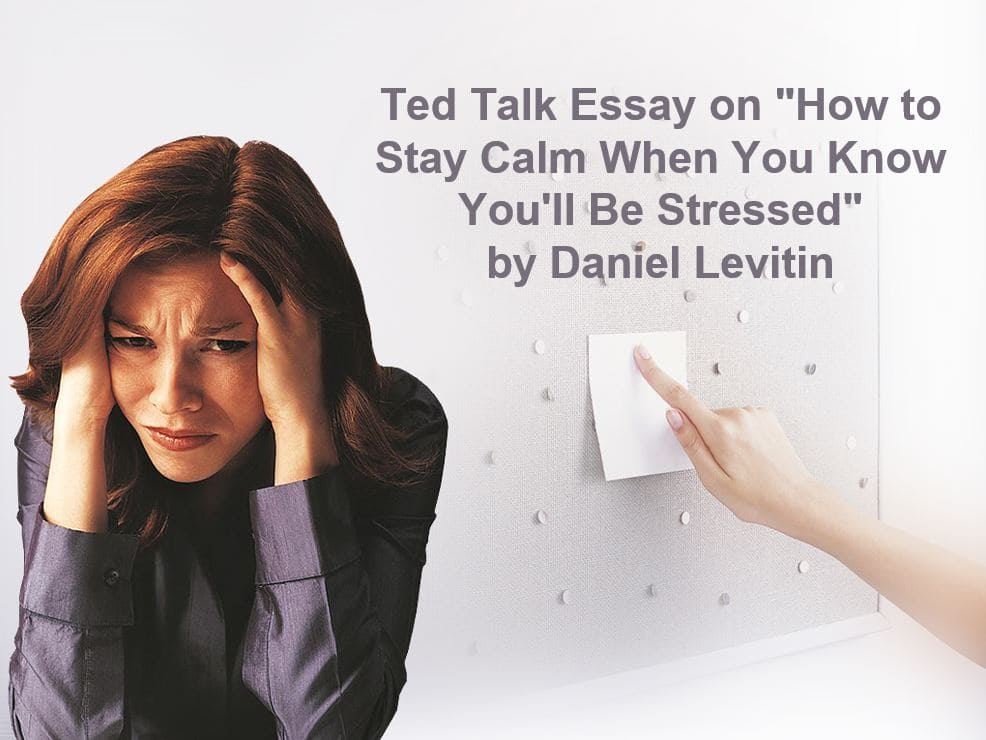In this Ted Talk essay on “How to Stay Calm When You Know You’ll Be Stressed” by Daniel Levitin, the author describes the best ways to manage stressful situations. In particular, he explains how pre-mortem or prospective hindsight can be applied to achieve this objective. Levitin mainly expounds on the concept of pre-mortem, which may help people like me to make better decisions, encouraging viewers to think about their future and apply pre-mortem in planning by considering the surprisingly high number needed to treat (NNT).
Key Concept
The main point of the video is that pre-mortem is a great approach to managing stress. This technique requires one to determine what could go wrong in the future and then prevent any problems noted (Levitin 03:36-03:48). Using this approach works since people tend to make rational decisions when they are not stressed. Thus, Levitin emphasizes the need to use it to make future plans.

Personal Experiences
I can relate the use of the concept of pre-mortem to several personal experiences. Members of any team need to identify issues that may lead to failure and then discuss the measures that should be taken to mitigate the threats (Mills and McKimm 584). In the group projects I participated in, each of us would write down the possible risks and then collectively decide on how to prevent them. This approach has also positively impacted my experiences in many other areas, including making financial decisions and preparing for exams.
Importance of the Information
Levitin’s presentation is important since it educates viewers on the need to think about the future. Pre-mortem requires people to think ahead of time (Levitin 10:13-10:20). For this reason, individuals can engage in logical reasoning when planning for future situations, such as managing health conditions. Hence, they can make rational decisions relating to their quality of life in the coming years.
Applying the Concept
I can apply prospective hindsight to make important decisions and plans. Pre-mortem can help me in making choices relating to my finances, social life, and medical care (Levitin 06:17-06:24). By using this approach, I can properly plan for the future when I am not stressed. Further on, this concept can help me manage projects by identifying potential risk factors that may lead to failure (Agency for Healthcare Research and Quality [AHRQ] par. 2). I can use this technique to come up with a plan to mitigate threats in any work I undertake. Therefore, I can apply the information presented by Levitin in several areas.
The Most Surprising Thing
The thing that surprised me the most is that many drugs do not work for a significant percentage of patients. Researchers have found that 90% of drugs being effective in treating only 30-50% of people (Levitin 07:49-07:55). These findings show that the number needed to treat one person is high, meaning that some treatment models may not be helpful to many people. NNT is a statistical presentation of the possible impacts of drugs or healthcare interventions (Everitt 185). Without this information, patients may not make the most appropriate decisions. Thus, I find the statistics presented to be surprising since the NNT is high and may lead to side effects.
Conclusion
Pre-mortem, as described by Levitin, impacts what I do for personal growth, encourages people to think ahead of time, and helps in planning for the future, including considering the surprisingly high NNT during medical care. I can apply this technique to identify potential threats and make decisions relating to finances, personal development, and project management. Therefore, people can use this approach to effectively manage stressful situations.
Works Cited
Agency for Healthcare Research and Quality (AHRQ). “Premortem Tool.” 2017, www.ahrq.gov/hai/tools/mvp/modules/cusp/premortem-tool.html.
Everitt, Brian S. Medical Statistics From A to Z: A Guide for Clinicians and Medical Students. Cambridge Univ Press, 2021.
Levitin, Daniel. “How to Stay Calm When You Know You’ll Be Stressed.” TED Talk, 2015, www.ted.com/talks/daniel_levitin_how_to_stay_calm_when_you_know_you_ll_be_stressed.
Mills, Jonathan K.A., and Judy McKimm. “Pre-Empting Project Failure by Using a Pre-Mortem.” British Journal of Hospital Medicine, vol. 78, no. 10, 2017, pp. 584–585, doi:10.12968/hmed.2017.78.10.584.


